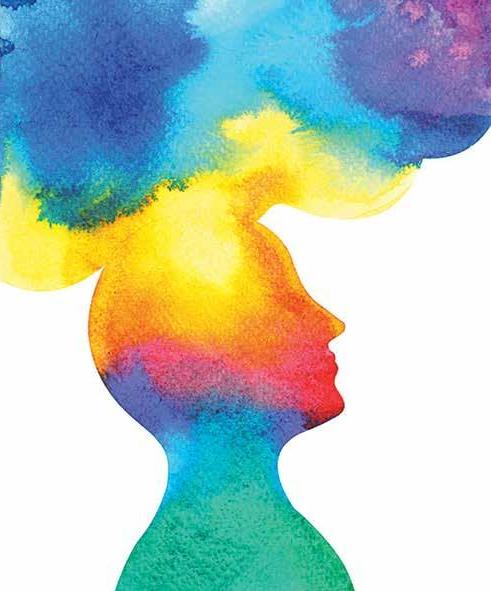
11 minute read
healing ways
Healthy Brain Strategies
How to Prevent Cognitive Decline
Advertisement
by Linda Sechrist
Ahealthy brain performs mental processes known as cognition, which is the acquiring of knowledge and understanding by means of thought, experience and the senses. This includes functions and systems such as memory, learning, language, problem solving, decision making, reasoning and intelligence. The aging process, a stroke or a brain injury can cause a mild to severe reduction in healthy brain functioning resulting in impaired memory and concentration, and difficulty in learning new things or making decisions that impact daily living.
benjavisa ruangvaree/AdobeStock.com
Functional medicine experts focused on preventive health care agree on the ABC’s for optimizing the brain and protecting against decline: eating a healthy diet, exercising, reducing inflammation and stress levels, balancing hormone levels, cultivating healthy relationships and getting enough restorative sleep. With their expertise, they are helping to shift the old paradigm of inevitable aging and cognitive decline into a new one based on the brain’s neuroplasticity.
Harvard-trained neuroscientist Jill Bolte Taylor, author of the bestseller My Stroke of Insight and the recent Whole Brain Living, is a true poster child for demonstrating the brain’s neuroplasticity and ability to recover from a massive stroke. She writes about the congenital neurological brain disorder that became a problem when an arteriovenous malformation exploded in her brain’s left hemisphere. For four hours, she observed her brain functions systemically shutting down one by one. On the afternoon of her stroke, she could not walk, talk, read, write or recall any of her life. Eight years later, she was not only slalom waterskiing again, but also explaining to the world, “We are the life-force power of the universe, with manual dexterity and two cognitive minds. We have the power to choose, moment to moment, who and how we want to be in the world.”
Devaki Lindsey Berkson, author of Sexy Brain, a hormone formulator and former researcher at Tulane University’s estrogen think tank, advises, “Most people think hormones are sexy, reproductive things and when they get older, they’re relieved that they don’t have to think about
them. Not true. The body has a virtual physiological internet system. Hormones are the email signals to most cells. While the robustness of hormones and their signals affects lungs, gut, kidney and vocal cord health, it especially affects the brain. Balancing hormones with bioidentical hormones is one solution.”
David Perlmutter, neurologist and co-author of Brain Wash, cites food as the biggest player in both brain and overall health in his books and PBS workshops. “Eating inappropriately causes intestinal permeability, resulting in inflammation, which in the brain, threatens good decision making—from deciding on the foods we eat to turning off our televisions at night, getting a good night’s rest, making sure that we exercise regularly and connecting with other people. Not good for the gut are dairy products, alcohol, highly processed foods that are low in fiber, high in sugar and refined carbohydrates, as well as antibiotics,” he says, adding that meditation and exposure to nature are powerful ways of reducing inflammation in the body and brain.
As explained by neurologist Dale E. Bredesen, author of The End of Alzheimer’s, stress leads to an increase in cortisol levels that can be toxic to our brains—in particular the memory— consolidating the hippocampus, one of the first structures affected by Alzheimer’s. Studies show that high stress levels can also contribute to brain fog, involving difficulty concentrating, forgetfulness and mental fatigue. The Bredesen Protocol, available from health practitioners and online, includes exercising, eating a plant-based diet, supplementing to reduce insulin sensitivity and optimize cognitive function, reducing both gut inflammation and exposure to toxins, treating pathogens and optimizing sleep.
HealthyBrains.org, Cleveland Clinic’s Healthy Brains Initiative, is an online resource center with information on how to manage brain health and create a brain span that matches a life span. It offers six pillars of brain health as explained by brain health experts, including exercise, sleep, relaxation, mental fitness and social interaction.
Supplementing for brain health should be done wisely, says Mark Hyman, author of Food: What the Heck Should I Eat? and director of functional medicine at Cleveland Clinic. He recommends at the very least taking a multivitamin and mineral supplement, omega-3, extra vitamins B3, B6 and B12, folate and a good probiotic that enhances the brain-gut relationship. Mastery of the ABC’s in kindergarten is required as the foundation of language and a lifetime of learning. Living the fundamentals for a healthy brain can result in a brain span that equals our life span.
Linda Sechrist is a Natural Awakenings senior staff writer. Connect at LindaSechrist.com.



nikkizalewski/AdobeStock.com



Four Steps to a Good Death
by Ronica O’Hara
On his deathbed, Apple founder Steve Jobs looked for a long time at his children, his sister and his wife, then moved his gaze to the space behind them. “Oh wow! Oh wow! Oh wow!” he gasped. No one can know for certain what he was experiencing, but his words point to the deep, mysterious potential of our final hours—the awareness of which can transform our life long before its end. “An awareness of dying, of death, can wake us up to life. It helps us live a life that’s rich and full and meaningful. When we deny the truth of dying, we live less wholeheartedly, less completely,” says Frank Ostaseski, founder of the pioneering San Francisco Zen Hospice Project and author of The Five Invitations: Discovering What Death Can Teach Us About Living Fully.
The pandemic has 51 percent of us thinking more about our own mortality, a survey shows. The subject of death has been slowly opening up in America: TV programs like Six Feet Under and Alternative Endings: Six New Ways to Die in America present dying and grief more realistically; thousands of small conversational gatherings called “death cafes” are being held each year; people are designing their own funerals and choosing green burial sites; and the field of “death doulas” is emerging to help families navigate the legal and emotional shoals. Half a century after the release of Elisabeth Kübler-Ross’ seminal book On Death and Dying, palliative care to ease pain is offered by two-thirds of American hospitals, and Medicare funding for end-of-life hospice care has grown tenfold over the last two decades.
Yet for many, death remains the last taboo—85 percent of us have not discussed our last wishes yet with loved ones. Thousands of studies in the emerging field of experimental existential psychology have found that when reminded subconsciously of death, people tend to drive faster, drink harder, smoke more and get meaner to out-groups in attempts to lower their anxiety.
But when we look death squarely in the face, that anxiety recedes, the research concludes. Gratitude, self-honesty and the humility of recognizing our place in the larger whole are also proven antidotes. With less fear, we are better able to take the proactive, concrete steps that ease our passage—getting clear on our values and desires, having important conversations, attending to final decisions and opening to our spiritual process. Although death has its own ways and means, these four processes can make it more likely we will die as we would like to.
Defining What We Value “Deeply consider what your priorities in life are,” says Tarron Estes, founder and CEO of The Conscious Dying Institute, in Boulder, which has trained more than 6,500 doulas since 2013. “Ask yourself, if I had only three months to live, what’s important to me spiritually, emotionally, physically? What do I still need to do or say?” She recommends Stephen Levine’s book, A Year to Live, for exercises and meditations for that process.
“Don’t wait until the time of your dying to discover what it has to teach you,” advises Ostaseski, who has sat beside more than 2,000 hospice patients in their last hours. “When I’m with dying people, the things that are important to them are not their spiritual beliefs, but are more about relationships—‘Am I loved? Did I love well?’ Those two questions are useful inquiries now. They help us to discover where value and meaning can be found.”
By applying our values to the dying process, we can start sorting through options. Do we want to die at home or in a hospital? What medical procedures will we accept or decline? What measures do we want to be taken to sustain our life? Who do we want to be at our side? And what do we need to say before that time? Having Important Conversations As daunting as the
prospect of an end-of-life talk with family and friends may seem, it can start with simple words like “I want to talk with you about something important to me.” Without spelling out our desires, death can become inadvertently medicalized: Nine in 10 of us say we want to die in our homes, but only two in 10 do. “The default systems are all to treat, treat, treat, until someone finally says, ‘No,’ so many people end up on a high-tech conveyor belt to the ICU,” says award-winning journalist Katy Butler, author of The Art of Dying Well: A Practical Guide to a Good End of Life. Among people that undertake such talks, 73 percent describe the experience as positive, reassuring and productive. A downloadable Conversation Starter Guide (TheConversationProject.org) provides practical guidance for these critical conversations. Attending to Medical and Burial Decisions Taking care
of business—the paperwork aspects of death known as advance directives—spares loved ones from having to make tough decisions later. A last will and testament precludes pain and infighting among family and friends. A living will specifies what treatments are wanted under what conditions. A medical power of attorney designates a trusted person to make medical decisions if a patient is not capable. A Do Not Resuscitate order approved by a doctor means emergency medical workers are less likely to give CPR, which frequently causes trauma and broken ribs in elderly or frail patients. Either cremation or a burial can be decided upon; environmental options such as a forest burial in a wooden casket can be explored. Local hospice options can be surveyed in advance; nonprofits generally are rated better than profit-making groups. Opening to the Spiritual Process Whether or not we have
religious beliefs to carry us through waves of loss and sorrow, death can spur spiritual insight. “In dying, we withdraw from our outer circles and come into the inner circles of our lives—the relationships that matter most to us,” says Ostaseski, who has worked four decades with hospice patients. “There’s a growing silence that has us becoming more contemplative and reflective. Our sense of time and space changes and we enter into a kind of free flow. The boundaries we have lived by begin to dissolve, and we start to feel ourselves as part of something larger—not as a belief, but as a natural occurrence. Often people realize themselves to be more than the small, separate self they had thought themselves to be.” Joan Tollifson, a Zen-trained spiritual teacher and author of Death: The End of Self-Improvement, concurs: “When the future disappears, we are brought home to the immediacy that we may have avoided all our lives. With no future left to fantasize about, the focus of attention may finally be fully on right Now, the only place where our life ever actually is. Really getting that ‘This is it,’ there may be a sudden recognition of the absolute preciousness and wonder of every simple ordinary thing and of the people around us, just as they are, with all their flaws and foibles. Old grudges and resentments often melt away, and love shines through.
“All the things which may have been part of our self-image—independence, physical strength, cognitive sharpness, good appearance and so on—have either disappeared or are rapidly collapsing, which invites the discovery that none of that really mattered, that what we truly or more fundamentally are is not dependent on any of that.
“The greatest gift we can give to a loved one who is dying,” says Tollifson, is to “simply be present, listen, follow your heart, trust the process. Everything else will follow from that. There’s no right or wrong way.”
It can be difficult to know what to say to a loved one near the end, but hospice workers recommend five phrases that have deep healing potential, even if a person seems unconscious: “I love you,” “Thank you,” “Please forgive me,” “I forgive you,” and “Goodbye” or “Until we meet again.” As Butler points out, the first four phrases can be said any time in our lives.
Increasingly in hospice care, loved ones are encouraged to sit with the body after the death, touching it, sharing stories, perhaps gently bathing it and dressing it in favorite clothes. “Touching the body, feeling the coolness, makes the death real to the family,” Ostaseski says. “Research shows that people that went through that process still grieved, but they were able to be with the emotion and not be overwhelmed by it.”
Facing the reality of death—as hard and heartbreaking as that can be—can free us to truly live life, said Jobs. After his terminal cancer diagnosis, he told Stanford students in a commencement address, “Remembering that I’ll be dead soon is the most important tool I’ve ever encountered to help me make the big choices in life. Because almost everything—all external expectations, all pride, all fear of embarrassment or failure—these things just fall away in the face of death, leaving only what is truly important. Remembering that you are going to die is the best way I know to avoid the trap of thinking you have something to lose. You are already naked. There is no reason not to follow your heart.”
Health writer Ronica O’Hara can be contacted at OHaraRonica@ gmail.com.








